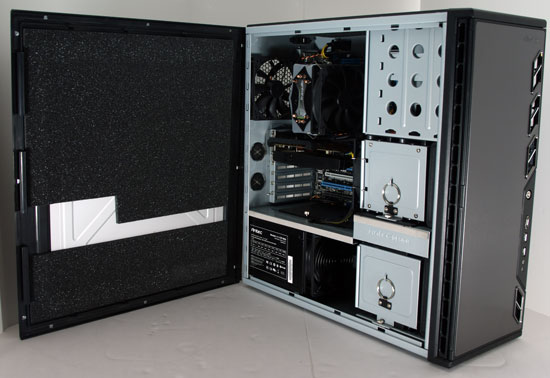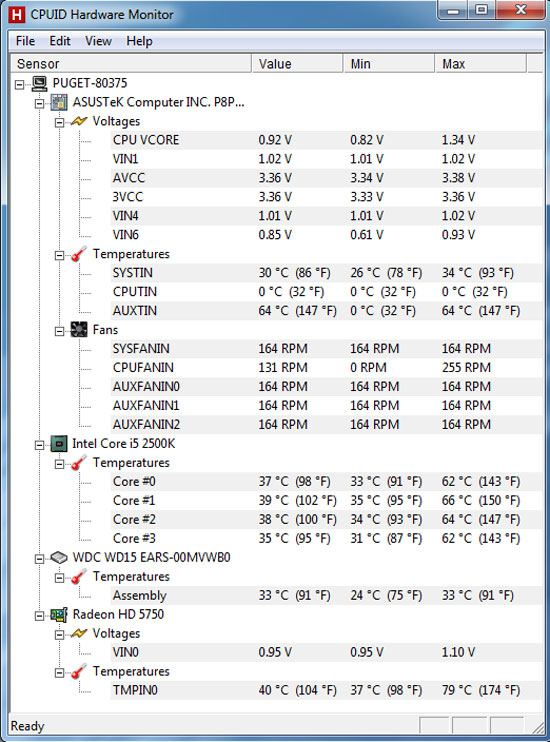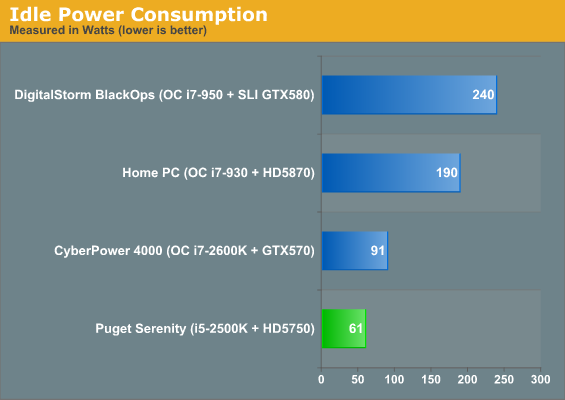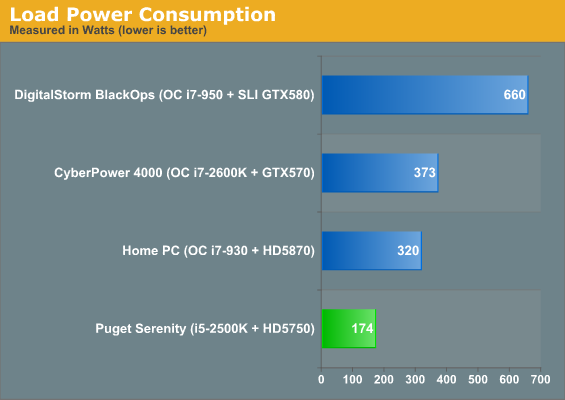Puget Systems Serenity SPCR Edition: Blissful Silence
by Dustin Sklavos on February 10, 2011 12:00 AM EST- Posted in
- Systems
- Intel
- Radeon
- Sandy Bridge
- Puget Systems
- Serenity SPCR
Build, Noise, Heat, and Power Consumption
Given the somewhat exotic nature of Puget Systems's Serenity SPCR Edition tower, it's reasonable to assume that there just aren't any good corners to cut. I'm happy to report that, having examined the system, Puget Systems simply couldn't and didn't.
What makes the build particularly interesting compared to the others is that, as I mentioned in the introduction, this really is a custom build, not just a melange of carefully chosen and assembled parts. Take a look inside and see what I mean.

Seeing the additional foam padding on the inside of the side panel when I had to remove the internal packing was a major cue, and the foam has been carefully cut to fit around the internals of the Antec P183 case used for the build. From the photo you can see three major points in Puget Systems's favor: quality case, quality power supply, and additional custom sound dampening. What's harder to see is that Puget Systems removed the Antec Tricool fans from the case and replaced them with silent Scythe 120mm fans. They've also bracketed an additional fan to the top hard drive tray, and they've removed the top exhaust fan and covered the vent with foam.
Another interesting point is the use of an air cooler instead of a watercooling system on the processor. I've reviewed more desktops with watercoolers than not and they're generally considered among the quietest ways to go, but here Puget Systems opts to use an air cooler—the Gelid Tranquilo—with a silent fan. They also carefully tuned the fan speeds in the ASUS board's UEFI to ensure silent running.
Certainly building the entire system for low noise is going to mean running a little hotter than normal, though, right? Interestingly, that's not the case.

Check out those thermals. The Serenity SPCR Edition keeps everything running remarkably frosty, and that's due in no small part to the attention paid to airflow inside the case. The P183 was already an excellent case with great thermals (we actually have a review unit on hand and we'll be posting a case review in the coming months), but the modified cooling produces airflow moving in effectively a straight line through the tower with minimal turbulence, allowing the fans to run at low speeds without compromising thermal performance. Even the Radeon doesn't crack 80C.
With those temperatures and the system's configuration in mind, these power consumption figures should come as no surprise to you:


We tested power consumption by idling at the desktop, and then running our Left 4 Dead 2 timedemo. In my experience, very few games are capable of pulling as much power from a system as Left 4 Dead 2 can. Something about the Source engine's relatively frugal usage of graphics hardware lets the processor and video power consumption scale well together.
Under load, Puget Systems's Serenity SPCR Edition draws less power than my fairly frugal desktop does at idle. Sandy Bridge has proven to be stunningly power efficient in the testing we've been able to do (we really can't wait to get our hands on more Sandy Bridge-equipped notebooks), and combining that with the already efficient Radeon HD 5750 keeps power consumption low. The next system up on the list—my home tower—draws nearly twice as much power under load. That increase in power draw may be commensurate with the increase in gaming performance, but keep in mind the i5-2500K is able to handle processor-intensive tasks much more efficiently than the i7-930.
















139 Comments
View All Comments
kevith - Thursday, February 10, 2011 - link
I read the review at SPCR a while ago.If one could talk about "craftsmanship" when referring to building computers, these guys would be he Formula 1 techs of quiet computer building. These guys' work doesn't come cheap, I don't really find the price all that monstrous, when I consider the hours spent.
I'm a muscician, and ths is the first ever, real quiet, almost silent machine I've ever seen even near this pricepoint. And I'm sure I could live with the 20 dB "hurricane" of the little-brother, at an even friendlier price. And I'd probably go with a graphics card with one of modern, very quiet aftermarket supercoolers.
(There's one little catch in musicproduction-PC's, regarding to graphics cards. I use Nuendo, a high-end, 2.500 $ DAW. As for now, I have an XFX HD4770. And, as most moderne graphics cards, it throttles itself when doing 2D-work, in my case from 750 mHz to 250 mHz core. While work in the DAW isn't 3D, it actually has some pretty demanding tasks, graphics-wise: When you zoom in and out in the editor window with a lot of tracks open; When you move large chunks of audio-material; When you pan across a whole song; When you use the Mixer-window that has a lot of real-time moving details like meters, graphs etc. These, and a lot of other operations you do all the time, will put so much strain on the video-card, that the low-performance clock isn't really enough, causing glitches, delays and brief lock-ups in the system. Of course, this is amplified the more tracks you have. I'd wish I could control these frequencies, but only the high-performance can be altered in AMD Overdrive, as soon as you return to 2D-work, the core-clock will drop to 250. Just to say, that the graphics card should be researched and considered thoroughly, even in a music-production machine.)
I live in Europe, so I can't buy it anyways.
However, I really dig the article, it's VERY inspiring, this is a project I'm definitely going to copy for my next build.
Tear it apart and give us some nice close-ups of the sound-dampening details... Just kidding:-)
7Enigma - Thursday, February 10, 2011 - link
Check out ATI tool. It is a free, beta program that allows for changing both 2D and 3D frequencies independently. Most of us use it to downclock our numbers, but in your situation you could ramp up the 2D clocks. Google Tech Power Up and Ati Tool and you'll get a link to the program. It's still a beta that is probably never going to see a final release but for a lot of us it offers something that is not available anywhere else.HTH
7Enigma - Thursday, February 10, 2011 - link
One thing I forgot to mention. You need to select the SAME frequency for low, medium, and high, or else you get a screen flickering bug on some cards (mine included). But if you set all the 2D (or 3D) settings to the same frequency the issue goes away.7Enigma - Thursday, February 10, 2011 - link
And I'm an idiot. I meant gpu tool, not ati tool (they are different programs). Everything else still applies though that I mentioned in the previous posts. Just go here:http://www.techpowerup.com/downloads/1383/gputool_...
rpsgc - Thursday, February 10, 2011 - link
Tell them to start using higher end video cards with aftermarket coolers. AC Accelero Xtreme Plus, Accelero Twin Turbo Pro, Gelid Icy Vision, Thermalright Shaman, Thermalright Spitfire, etc.With such a slew of great coolers, there's no reason not to use them, and not to use more powerful video cards.
KayDat - Thursday, February 10, 2011 - link
I'm speaking particularly for the SPCR build, but with a computer at such a low noise floor, a lot of graphics coolers (yes, even third party ones) may be positively noisy in comparison. Yes, the option would be nice, but Puget spend time cherry picking parts for SPCR build, they wouldn't put in parts that aren't up to scratch.Taft12 - Thursday, February 10, 2011 - link
Any of those coolers would obliterate the 11dB they were able to obtain. You might not realize what an achievement that is, but suffice to say passive GPU cooling is a must.kmmatney - Friday, February 11, 2011 - link
I have a somwhat similar setup, with an Antec P-182 case, that I built for silence. I have an HD4890 that was completely unbearable witht he stock fan. I placed in an Accelero on it, along with a silent, low-speed fan blowing across it , and its both silent and stays cool.michal1980 - Thursday, February 10, 2011 - link
why did they pick a 850W PSU? System runs low power, was so smartly desgined, and then they drop this beast in there? Why? Imho, stupidy.Futhermore, seems like there was some ass-kissing in this review
"That said, many of the really high scores we've seen are largely academic: can anyone really tell the difference between 100 frames per second and 150... 30 frames per second ...framerate should still be your baseline for acceptable performance"
Where did this pc hit 100 fps? Yes over 100fps would be academic. Over 60fps could be academic, 16fps for 2 grand? I'll tell you what that is, pathic. As are most of the graphic tests. The performance isn't good, its SAD.
30 frames per second a human eye limit, you just panadoring to Puget, for its pathic attempt at a 'performance' machine. Please get back to us, when you get some balls to call things as they are. For a gaming pc this is sad.
Maybe next time they should go for zero dB, solid state drives, a slow passivle cold pc. heck slap an ipad in case, look man this thing makes no sound. No one can tell the difference between this and a performance pc. just 3 grand.
nikclev - Thursday, February 10, 2011 - link
Just commenting on the choice of power supply. The CP-850 is the smallest that antec makes in the CPX (or whatever they call it) proprietary form factor. Basically bigger dimensions, it allows for a bigger fan and more room inside the PSU. It also performs extremely well and is considerably cheaper than most other high quality PSUs in the same wattage range. Every review I've seen of the CP power supplies lists it as one of the best when it comes to voltage stability and lack of ripple/noise/etc. And yes, it is more power supply than this system needs. I think that is a good thing. Too many computer manufacturers use power supplies that do not allow any room for expansion/cap ageing purely to save money.I agree with you to a point about the lack of gaming performance.I think in this case silence was priority number one. I've owned several high performance graphics cards and purposely set in game settings lower than I had to, just to keep the thing quiet.
I agree with the review, It seems like an excellent computer with boutique quality AND price tag, but lacking in the warranty department. (At least when you compare advertised numbers with other manufacturers)